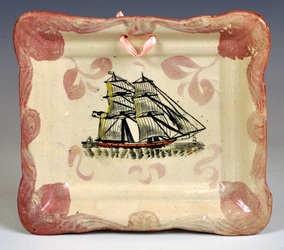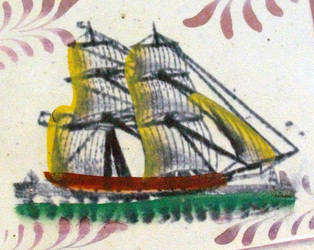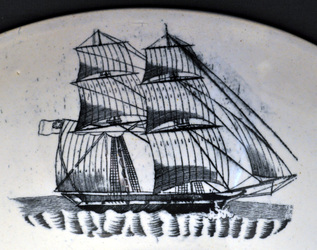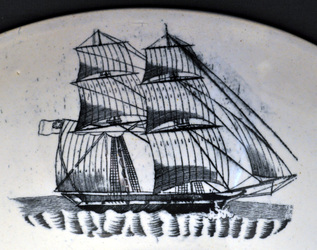|
Please read my previous blog post first. A variant of the third ship transfer on the bowl, which I said was the most common of the series, appears on plaques with a circular impressed mark for Galloway & Atkinson's Albion Pottery (c1864). On the Albion plaques, the ship is titled 'Gudrun' (see first plaque below). I've not been able to find out anything yet about the ship Gudrun. As with the bowl, this plaque has a firing crack and glaze imperfections, and was therefore left undecorated. So did G&A (or C T Maling, their predecessor at the pottery before they changed its name to 'Albion'), make the other plaques below? Perhaps the title 'Gudrun' was added at a later date? The plaque below is much better quality than those that follow it. I'd guess it was made c1850s. Compare the right detail with the Gudrun plaque above. Though the waves follow a similar formation, they are clearly from different plates. Also look at the shape of the flags in the centre detail and note the seagulls on the plaques below. Here's the plaque from my previous post, with the transfer that didn't match the bowl. It does, however, match the transfer on the plaque above. The two larger plaques beneath it, usually attributed to John Carr's Low Lights Pottery, also have transfers from the same plate. They were produced around the same time as the Gudrun plaque (c 1860s), but note how the quality of the imprint has deteriorated. N.B. one of the two ships on the right of the horizon has disappeared on the later plaques (click details to enlarge). So to recap, there are at least three variations of the transfer, which I've shown below for comparison. The first one titled Gudrun was used by the Albion Pottery on plaques with the G&A impress. The second appears on larger plaques attributed to John Carr. The bowl is still a bit of a mystery. For the reasons stated in my previous posting, I think it is Carr. This would mean that Carr had two very similar transfer plates. But why not? Remember that Anthony Scott had four almost identical 'Prepare' transfer plates. So does the third transfer (on the bowl) ever appear on plaques? Yes it does. The orange plaque below has a rare 'portrait' orientation. It is from an as yet unidentified pottery, perhaps dating from as late as the 1890s. Ball's Deptford Pottery is the default attribution for orange lustre plaques. But J Carr and Sons continued to produce pottery until 1900. Thanks to Ian Holmes for his comments and for helping me out with photos. Have you visited the United Collections website recently?
0 Comments
Leave a Reply. |
AuthorStephen Smith lives in London, and is always happy to hear from other collectors. If you have an interesting collection of plaques, and are based in the UK, he will photograph them for you. Free advice given regarding selling and dispersal of a collection, or to those wishing to start one. Just get in touch... Archives
February 2022
AcknowledgementsThis website is indebted to collectors, dealers and enthusiasts who have shared their knowledge or photos. In particular: Ian Holmes, Stephen Duckworth, Dick Henrywood, Norman Lowe, Keith Lovell, Donald H Ryan, Harold Crowder, Jack and Joyce Cockerill, Myrna Schkolne, Elinor Penna, Ian Sharp, Shauna Gregg at the Sunderland Museum, Keith Bell, Martyn Edgell, and Liz Denton.
|




















